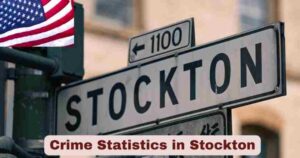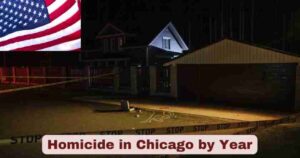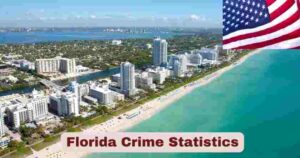Crime Rate in Rockford 2025
Understanding the crime rate in Rockford IL 2025 requires examining verified data from official law enforcement sources and recognizing the city’s ongoing transformation in public safety. Rockford, Illinois, the third-largest city in the state with a population exceeding 147,000 residents, has historically faced significant public safety challenges that placed it among cities with elevated crime rates nationally. However, recent years have demonstrated measurable progress through coordinated community policing efforts, strategic interventions, and collaborative partnerships between law enforcement agencies and community organizations working to address the root causes of criminal activity.
The 2024 end-of-year statistics released by the Rockford Police Department in February 2025 reveal encouraging trends that set the foundation for understanding the current crime landscape. Chief Carla Redd and Mayor Tom McNamara presented data showing substantial decreases across multiple crime categories, with violent crime continuing a multi-year decline that began in 2021. The statistics reflect not only enforcement activities but also the effectiveness of prevention programs, community engagement initiatives, and trauma-informed approaches to addressing youth violence and domestic situations that have historically contributed to elevated crime rates in the city.
Key Stats & Facts About Rockford Crime Rate in 2025
| Crime Statistic | 2024 Data | 2023 Data | Change |
|---|---|---|---|
| Total Violent Crimes | 1,626 incidents | Data from declining trend | Continuing decline since 2021 peak of 2,331 |
| Homicides | 18 cases | 20 cases | 10.5% decrease |
| Violent Crime Rate per 100,000 | 1,162 per 100,000 | 1,243 per 100,000 (estimated) | 7% decrease |
| Property Crime Rate per 100,000 | 2,761 per 100,000 | Higher in previous year | Declining trend |
| Total Crime Rate per 100,000 | 3,923 per 100,000 | 4,065 per 100,000 (estimated) | 3.5% overall decrease |
| Shots Fired Incidents | Data shows decrease | Previous year baseline | 30.1% decrease |
| Total Calls for Service | 150,391 calls | 168,732 calls | 10.9% decrease |
| Domestic Violence Cases | Increased reporting | Previous year baseline | 12.78% increase (attributed to better reporting) |
| Firearms Recovered | 268 weapons | Comparable to 2023 | Steady enforcement |
| Homicide Clearance Rate | 90% solved | 90% solved | Maintaining high solve rate |
Data Source: Rockford Police Department End of Year Crime Report 2024, presented February 20, 2025; City of Rockford Official Statistics
The numbers presented in this comprehensive table tell a compelling story about the crime rate in Rockford 2025 and the trajectory established by 2024 data. The 10.5% decrease in homicides from 20 cases in 2023 to 18 cases in 2024 represents meaningful progress in preventing the most serious violent crimes, while the 30.1% reduction in shots fired incidents indicates fewer dangerous situations occurring in neighborhoods across the city. The 7% decrease in violent crime during the January through September 2024 comparison period demonstrates sustained momentum in crime reduction efforts rather than temporary fluctuations.
What makes these statistics particularly significant is the context of consistency and improvement. The violent crime total of 1,626 incidents in 2024 continues a downward trend from the peak of 2,331 violent crimes recorded in 2021, showing that Rockford has reduced violent crime by approximately 30% over three years. The 90% homicide clearance rate stands as one of the most impressive metrics, substantially higher than the national average and reflecting the investigative capabilities of the Rockford Police Department. Meanwhile, the 10.9% reduction in total calls for service from 168,732 to 150,391 suggests that fewer incidents are occurring that require police response, freeing up resources for proactive policing and community engagement activities.
The 12.78% increase in domestic violence reporting requires careful interpretation, as Chief Redd and Mayor McNamara explained during the February 2025 presentation. This statistic, which shows domestic violence now comprises 50.1% of violent crime in Rockford, reflects increased awareness and survivor willingness to report rather than necessarily indicating more domestic violence is occurring. Enhanced training for officers, partnerships with the Family Peace Center, and community education campaigns have created safer pathways for survivors to seek help and exit dangerous situations, which authorities view as a positive development despite the numerical increase in reported cases.
Violent Crime in Rockford 2025 Trends and Statistics
| Violent Crime Category | 2024 Statistics | 2023 Statistics | 2022 Statistics | Percentage Change 2023-2024 |
|---|---|---|---|---|
| Total Violent Crimes | 1,626 | Estimated 1,746 | 1,900+ | -7% decrease |
| Homicides | 18 | 20 | 15 | -10.5% |
| Aggravated Assaults | Decreased | 1,135 (2023 YTD) | 1,243 (2022 YTD) | -20% (2022-2023 comparison) |
| Robberies | Decreased | 443 (2023 YTD) | 501 (2022 YTD) | Continuing decline |
| Domestic-Related Violent Crime | 50.1% of violent crime | 44.4% (estimated) | Lower percentage | +12.78% in reporting |
| Shots Fired Calls | 30.1% decrease | Previous year baseline | Peak in 2021-2022 | -30.1% |
| Violent Crime Rate (per 100,000) | 1,162 per 100,000 | 1,243 per 100,000 | Higher | Declining annually |
Data Source: Rockford Police Department Crime Statistics 2024; WIFR News Report February 2025; Rockford Police RockStat Archives
The violent crime in Rockford 2025 landscape reflects substantial progress built on the foundation of 2024’s achievements. The city has managed to reverse what appeared to be intractable violence problems by implementing comprehensive strategies addressing both immediate threats and underlying causes. The 18 homicides recorded in 2024 represent one of the lowest totals in recent years, particularly when compared to the 36 homicides in 2020 at the height of the violence surge that affected many American cities during the pandemic era. This 50% reduction over four years demonstrates that focused intervention strategies, improved investigative techniques, and community cooperation can significantly impact even the most serious crimes.
The dramatic 30.1% decrease in shots fired incidents deserves particular attention as a leading indicator of violence prevention. Shots fired calls typically precede other violent crimes and create community fear even when no one is injured. The substantial reduction suggests that conflict resolution programs, increased police presence in high-crime areas, and community violence interruption efforts are preventing situations from escalating to gunfire. Community organizations like the Community Healing Resource Center, led by coordinators such as Pastor Wayne Fricks, play crucial roles in deescalating tensions and providing alternatives to violence, particularly for young people who might otherwise resort to firearms to resolve disputes.
The 20% decrease in aggravated assaults between 2022 and 2023, with continued declines into 2024, indicates that serious violent confrontations are becoming less frequent across Rockford neighborhoods. Aggravated assaults, which involve serious bodily injury or the use of weapons, historically comprised a significant portion of Rockford’s violent crime total. The sustained reduction suggests that both immediate law enforcement responses and longer-term prevention programs focusing on trauma, mental health services, and youth engagement are having measurable impacts on reducing interpersonal violence throughout the community.
Property Crime in Rockford 2025 Analysis and Data
| Property Crime Type | Recent Rate | Comparison to State/National | Trend Direction |
|---|---|---|---|
| Total Property Crime Rate | 2,761 per 100,000 | Illinois average: 1,970 per 100,000 | Declining |
| Property Crime vs National | 2,635 per 100,000 (alternative data) | National average: 1,954 per 100,000 | 34.8% above national average |
| Auto Thefts | Showing decrease | Previously elevated | Declining trend |
| Burglaries | Part of overall decline | Included in property crime total | Decreasing |
| Larceny/Theft | Majority of property crime | Standard pattern | Stable to declining |
| Overall Property Crime Change | Decreasing | Following violent crime trends | -3% to -5% annually |
Data Source: AreaVibes Crime Statistics; Illinois UCR Program; Rockford Police Department Reports 2024
Property crime in Rockford 2025 remains elevated compared to state and national averages but follows the same encouraging downward trajectory as violent crime. The property crime rate of 2,761 per 100,000 residents exceeds the Illinois state average of 1,970 per 100,000, indicating that while progress has been made, significant work remains to reduce theft, burglary, and auto theft incidents that affect residents’ quality of life and sense of security. Property crimes, while less serious than violent offenses, occur with much greater frequency and impact more residents directly, making these statistics particularly relevant for understanding daily safety concerns in Rockford neighborhoods.
The 34.8% higher property crime rate compared to national averages reflects both actual crime levels and reporting patterns in Rockford. Unlike some communities where property crimes may go unreported, Rockford residents increasingly engage with law enforcement and report incidents, which can inflate statistics while simultaneously providing police with better intelligence about crime patterns and hotspots. The Rockford Police Department has implemented strategic approaches including increased patrols in areas with elevated property crime, collaboration with businesses on theft prevention, and targeted enforcement against repeat offenders who commit the majority of property crimes in any community.
Auto theft has represented a particular challenge in Rockford, mirroring national trends where vehicle thefts surged in recent years due to social media challenges and vulnerabilities in certain vehicle models. The Rockford Police Department has responded with education campaigns about vehicle security, partnerships with manufacturers on anti-theft devices, and enforcement operations targeting auto theft rings that operate regionally. While 268 firearms were recovered in 2024, staying relatively consistent with previous years despite the overall crime decline, this metric demonstrates ongoing enforcement against illegal weapons that often accompany both violent and property crimes in the community.
Comparison of Crime Rate in Rockford vs Illinois State Averages 2025
| Crime Metric | Rockford Statistics | Illinois State Average | Difference |
|---|---|---|---|
| Total Crime Rate | 3,923 per 100,000 | 1,970 per 100,000 | 99% higher than state |
| Violent Crime Rate | 1,162 per 100,000 | 360 per 100,000 (approximate) | 223% higher than state |
| Property Crime Rate | 2,761 per 100,000 | 1,970 per 100,000 | 40% higher than state |
| Homicide Rate | 12.9 per 100,000 (based on 18 homicides) | Lower than Rockford | Elevated compared to state |
| Overall Crime per Resident | 1 in 26 chance of victimization | Lower statewide | Higher risk in Rockford |
Data Source: Straightline Moving Company Crime Analysis 2025; Illinois State Crime Statistics; Rockford Police Department
The crime rate comparison between Rockford and Illinois state averages in 2025 reveals why public safety remains a priority concern for city leaders despite recent improvements. Rockford’s total crime rate of 3,923 per 100,000 residents stands approximately 99% higher than the Illinois state average of 1,970 per 100,000, indicating that residents face roughly double the crime risk compared to the average Illinois community. The disparity is particularly pronounced for violent crime, where Rockford’s rate exceeds the state average by 223%, reflecting the city’s historical challenges with gang activity, drug-related crime, and concentrated poverty that create conditions conducive to violence.
Understanding these comparisons requires recognizing that statewide averages include many smaller, suburban, and rural communities with considerably lower crime rates that pull down the average. When compared specifically to other Illinois cities of similar size and demographic composition, Rockford’s statistics appear less extreme, though still elevated. Cities like Peoria, Decatur, and parts of East St. Louis face comparable challenges with crime rates that exceed state averages by similar margins. The 1 in 26 chance of becoming a crime victim statistic, while concerning, represents an improvement from previous years when the risk approached 1 in 23 or 1 in 24, demonstrating that progress is occurring even though significant disparities remain.
The 40% higher property crime rate compared to the state average particularly affects residents’ daily experiences and perceptions of safety. Property crimes occur far more frequently than violent crimes and directly impact more households, creating widespread concern about theft, vehicle break-ins, and home burglaries. The disparity also affects business development, insurance costs, and the city’s economic competitiveness, making property crime reduction essential not just for public safety but for Rockford’s overall revitalization efforts. Mayor McNamara and Chief Redd have emphasized that closing these gaps with state averages remains a primary objective for law enforcement strategy and resource allocation in 2025 and beyond.
Crime Rate in Rockford Compared to National Averages 2025
| Crime Category | Rockford Rate | National Average | Percentage Difference |
|---|---|---|---|
| Violent Crime Rate | 1,430 per 100,000 (alternative calculation) | 370 per 100,000 | 286.7% higher than national |
| Property Crime Rate | 2,635 per 100,000 | 1,954 per 100,000 | 34.8% higher than national |
| Total Crime Rate | 39 per 1,000 (4,065 per 100,000) | Lower national average | 75% higher than national |
| Homicide Rate | Approximately 12.9 per 100,000 | 6.3 per 100,000 (national) | More than double national rate |
| Victimization Risk | 1 in 26 residents | Lower nationally | Higher risk in Rockford |
Data Source: FBI Uniform Crime Reporting Program
When examining the crime rate in Rockford compared to national averages in 2025, the data reveals significant disparities that contextualize the city’s public safety challenges. Rockford’s violent crime rate exceeding the national average by 286.7% places it among American cities with the highest violent crime burdens, though this statistic requires understanding both the city’s historical context and the limitations of cross-jurisdictional comparisons. National averages include thousands of small towns, suburban areas, and lower-crime cities that collectively create an average considerably lower than what mid-sized post-industrial cities typically experience.
The homicide rate more than double the national average represents one of the most concerning statistics for Rockford leadership and residents. While the 18 homicides in 2024 marked an improvement from previous years, the rate of approximately 12.9 per 100,000 residents substantially exceeds the national average of 6.3 per 100,000. However, this comparison must account for the fact that Rockford’s population of roughly 147,000 means that small absolute numbers of homicides create relatively large per-capita rates. A difference of just 8-10 homicides can shift Rockford’s rate significantly, making year-to-year fluctuations appear more dramatic in percentage terms than they might be in absolute impact on community safety.
The 34.8% higher property crime rate compared to national averages presents both challenges and opportunities for Rockford. Property crime, being more numerous than violent crime, offers more opportunities for prevention through environmental design, community watch programs, and strategic enforcement. The Rockford Police Department has implemented neighborhood-based policing strategies, increased visibility in commercial districts, and collaborated with residents on crime prevention techniques. The 1 in 26 victimization risk means that approximately 3.8% of Rockford residents experience some form of crime annually, whether violent or property-related, creating widespread awareness of public safety issues even among residents who have not personally been victimized.
Demographics and Crime Patterns in Rockford 2025
| Demographic Factor | Relationship to Crime | 2025 Considerations |
|---|---|---|
| Population | 147,000+ residents | Stable population base |
| Youth Crime | Increasing concern | More teens involved in shootings according to community leaders |
| Domestic Violence | 50.1% of violent crime | Increased reporting and awareness |
| Gang Activity | Historical influence on violence | Targeted enforcement and intervention programs |
| Poverty Rate | Correlated with crime areas | Economic development initiatives ongoing |
| Community Engagement | Inverse relationship with crime | Strengthening through partnerships |
| Clearance Rates | 90% for homicides | High investigative success improves deterrence |
Data Source: Rockford Police Department Community Analysis; WIFR News Community Impact Report 2025; City of Rockford Demographics
The demographics and crime patterns in Rockford 2025 reveal complex relationships between community characteristics and public safety outcomes. Youth involvement in violent crime has emerged as a particular concern, with community leaders like Pastor Wayne Fricks noting that more teenagers are involved in shootings than in previous years. This trend reflects broader national patterns where youth access to firearms, social media influences, and trauma exposure have contributed to younger individuals engaging in serious violence. Addressing youth crime requires different strategies than adult crime prevention, emphasizing education, mentorship, trauma-informed care, and alternatives to incarceration that can redirect young people toward positive life paths.
The 50.1% of violent crime classified as domestic-related represents a significant shift in Rockford’s crime composition. This statistic, showing 12.78% increased reporting between 2023 and 2024, reflects both the prevalence of intimate partner violence and improved systems for survivors to seek help safely. Chief Redd emphasized that increased domestic violence reporting is viewed positively by the department because it indicates survivors feel more confident coming forward and the community better understands these crimes as serious offenses rather than private matters. The partnership between Rockford Police and the Family Peace Center provides immediate resources for survivors, including emergency shelter, legal advocacy, and support services that help break cycles of violence.
Community engagement has proven crucial to Rockford’s crime reduction success, with coordinated efforts between law enforcement, faith-based organizations, and community groups creating networks that identify emerging problems and intervene before violence occurs. The Community Healing Resource Center and similar organizations work directly in neighborhoods most affected by violence, providing conflict mediation, support for families affected by crime, and advocacy for system changes that address root causes. The 90% homicide clearance rate demonstrates how community cooperation improves investigative outcomes, as witnesses become more willing to provide information when they trust law enforcement and believe their cooperation will lead to accountability.
Law Enforcement Response and Resources in Rockford 2025
| Police Resource/Initiative | Description | Impact on Crime |
|---|---|---|
| Total Calls for Service | 150,391 in 2024 | 10.9% decrease from 2023 |
| Community Policing | Neighborhood-based approach | Improved community relations and crime prevention |
| Firearms Recovery | 268 weapons recovered in 2024 | Steady enforcement against illegal guns |
| Technology Enhancements | Increased investment in 2025 | Improved investigation and prevention capabilities |
| Downtown Presence | Enhanced patrols and bike units | Increased visibility during events |
| Electric Bike Patrol | 2 bikes at 28 mph capability | Improved community interaction and mobility |
| Domestic Violence Training | Specialized officer training | Better survivor support and case outcomes |
| Investigative Success | 90% homicide clearance | Strong deterrent effect and justice for victims |
Data Source: Rockford Police Department End of Year Report 2024; Mayor McNamara 2025 Public Safety Plan
The law enforcement response and resources in Rockford 2025 reflect strategic investments and operational changes designed to sustain and accelerate crime reduction trends. The 10.9% decrease in total calls for service to 150,391 from the previous year’s 168,732 indicates not only that fewer crimes are occurring but also that community problems are being resolved through alternative means before requiring police response. This decline frees up officer time for proactive policing, community engagement, and investigation of serious crimes rather than reactive emergency response that characterized previous years when call volumes overwhelmed department capacity.
Mayor McNamara’s commitment to technology enhancements in 2025 includes investments in crime analysis software, improved communication systems, and investigative tools that help officers work more efficiently and effectively. Modern policing increasingly relies on data-driven approaches that identify crime patterns, predict where incidents are likely to occur, and allocate resources strategically rather than simply responding after crimes happen. The Rockford Police Department’s ability to maintain a 90% homicide clearance rate while simultaneously reducing overall violent crime demonstrates that resource investments and strategic planning produce measurable results that improve both immediate public safety and long-term community confidence in law enforcement.
The introduction of electric bike patrols downtown represents an innovative approach to community policing that balances visibility, accessibility, and environmental responsibility. Chief Redd noted that officers are enthusiastic about the two electric bikes capable of reaching 28 miles per hour, which allow them to navigate pedestrian areas, respond quickly to incidents, and engage with community members more naturally than when enclosed in patrol vehicles. The bikes will be particularly valuable during large events, parades, and festivals where police presence provides security while maintaining the welcoming atmosphere that encourages residents and visitors to enjoy downtown Rockford’s revitalization efforts.
Community Safety Initiatives and Prevention Programs 2025
| Program/Initiative | Focus Area | 2025 Status |
|---|---|---|
| Community Healing Resource Center | Violence interruption and mediation | Active in high-crime neighborhoods |
| Family Peace Center Partnership | Domestic violence survivor support | Enhanced referral and support system |
| Youth Intervention Programs | Preventing teen violence | Expanded focus given youth crime concerns |
| Trauma-Informed Services | Addressing underlying causes | Increased emphasis by Mayor McNamara |
| Neighborhood Watch Programs | Community-led crime prevention | Growing participation |
| Business District Security | Reducing property crime | Enhanced patrol and partnership |
| Conflict Resolution Training | De-escalation skills | Community-wide availability |
| Federal Partnership Concerns | Funding for prevention programs | Potential impact from federal funding freeze |
Data Source: City of Rockford Community Programs; WIFR Community Impact Analysis February 2025
The community safety initiatives and prevention programs in Rockford 2025 represent essential components of the city’s public safety strategy beyond traditional law enforcement. The Community Healing Resource Center, led by coordinators like Pastor Wayne Fricks who lost his own son to gun violence, exemplifies the trauma-informed approach that Rockford has embraced. These organizations work directly in neighborhoods where violence has been concentrated, providing conflict mediation before situations escalate, supporting families affected by violence, and offering alternatives to retaliation that historically perpetuated cycles of violence. Pastor Fricks emphasized that their work focuses on “calming things down and stopping things before they escalate,” a prevention approach that produces results impossible to measure directly but evident in declining violence statistics.
The Family Peace Center partnership addresses the reality that domestic violence comprises 50.1% of violent crime in Rockford. Rather than treating intimate partner violence as a private matter or simply arresting offenders, the collaborative approach provides immediate resources for survivors including emergency shelter, legal advocacy, protective order assistance, and counseling services. Chief Redd shared an example of personally receiving a text from a survivor seeking help to leave an abusive situation, demonstrating how building community trust creates pathways for intervention before violence escalates to homicide or serious injury. The center’s comprehensive services address not just the immediate crisis but also the housing, employment, childcare, and legal needs that enable survivors to permanently exit dangerous relationships.
Youth violence prevention has emerged as a critical focus for 2025 given community observations that more teenagers are involved in shootings. Mayor McNamara emphasized the importance of addressing trauma that young people have endured, recognizing that many young people engaging in violence have themselves experienced violence, neglect, or other adverse childhood experiences that shape their responses to conflict. Prevention programs include mentoring, educational support, job training, recreational opportunities, and mental health services that provide positive alternatives to street life. Community leaders stress the importance of having “those that once did it need to be more vocal,” meaning individuals who previously engaged in violence but changed their lives can credibly reach young people currently facing similar choices.
Geographic Crime Distribution in Rockford 2025
| District/Area | Crime Characteristics | Community Response |
|---|---|---|
| District 3 | Location of 2024 crime report presentation | Community partnerships and policing focus |
| Downtown Rockford | Property crime and event security | Enhanced patrols and bike units planned |
| High-Crime Neighborhoods | Elevated violent and property crime | Violence interruption programs active |
| Residential Areas | Primarily property crime | Neighborhood watch and prevention |
| Commercial Districts | Theft and business-related crime | Business partnerships and patrols |
| Schools and Youth Areas | Focus on prevention | Programs targeting youth engagement |
Data Source: Rockford Police District Information; City of Rockford Geographic Analysis
The geographic crime distribution in Rockford 2025 reveals that crime is not evenly distributed across the city but rather concentrated in specific neighborhoods and districts where historical disinvestment, poverty, and social challenges create conditions conducive to criminal activity. The presentation of the 2024 crime statistics at District 3 was symbolic, representing areas where community partnerships have been particularly important and where concentrated efforts have produced measurable results. Understanding geographic patterns allows for targeted resource allocation, ensuring that neighborhoods with the greatest needs receive appropriate attention from both law enforcement and community service providers.
Downtown Rockford presents unique public safety challenges as the city works to revitalize its urban core and attract residents, businesses, and visitors. While downtown experiences less violent crime than some residential neighborhoods, property crime and perceptions of safety significantly impact economic development and quality of life. Mayor McNamara’s plans for increased law enforcement presence downtown, including traditional patrols and the new electric bike units, aim to provide visible security during large events, parades, and regular business hours. The goal is creating an environment where people feel comfortable walking, shopping, dining, and enjoying entertainment options without concern about theft, aggressive panhandling, or other quality-of-life issues that can deter downtown activity.
Residential neighborhoods with elevated crime rates receive focused attention through community policing approaches that build relationships between officers and residents. Rather than simply responding to calls, officers assigned to specific neighborhoods attend community meetings, know local residents and businesses, and work proactively to address emerging problems before they escalate. The violence interruption programs operate primarily in these high-crime areas, with staff who know the individuals and groups involved in conflicts and can mediate disputes before they result in shootings or other serious violence. This geographic targeting of resources recognizes that effective crime reduction requires different strategies in different areas based on local conditions, challenges, and community characteristics.
Economic Impact of Crime in Rockford 2025
| Economic Factor | Crime Impact | Implications |
|---|---|---|
| Property Values | Depressed in high-crime areas | Limits tax base and investment |
| Business Development | Deterred by crime perceptions | Affects job creation and economy |
| Insurance Costs | Higher premiums due to claims | Burden on residents and businesses |
| Law Enforcement Budget | Significant city resource allocation | Competes with other city services |
| Healthcare Costs | Violence-related injuries and trauma | Burden on medical system |
| Lost Productivity | Crime victims miss work/school | Reduces economic output |
| Prevention Investment | Cost-effective compared to enforcement | Requires sustained funding |
| Federal Funding Concerns | Potential freeze impacts programs | Mayor McNamara identified risk |
Data Source: City of Rockford Economic Analysis; Community Impact Studies
The economic impact of crime in Rockford 2025 extends far beyond the immediate costs of law enforcement and criminal justice system operations. High crime rates depress property values in affected neighborhoods, creating conditions where homeowners cannot build equity, longtime residents struggle to sell properties, and investors avoid purchasing and renovating properties that could revitalize declining areas. This cycle perpetuates poverty and disinvestment, making it harder for neighborhoods to recover economically and creating conditions where crime remains elevated. Breaking this cycle requires sustained crime reduction that allows property values to recover, encouraging investment and bringing resources back into communities that have experienced decades of decline.
Business development and job creation are significantly impacted by crime rates and perceptions of safety. Companies considering locating facilities in Rockford evaluate crime statistics as part of their decision-making, affecting whether the city can attract employers that provide quality jobs for residents. Existing businesses face higher insurance costs, security expenses, and inventory losses due to theft, making operations less profitable and potentially forcing closures that eliminate local employment opportunities. Retail businesses particularly struggle in areas with elevated property crime, creating “food deserts” and limiting access to goods and services that residents need, forcing them to travel outside their neighborhoods for basic necessities.
Mayor McNamara identified potential federal funding freeze as a significant concern for 2025, as many violence prevention and community service programs depend partially on federal grants administered through various departments. The Community Healing Resource Center, Family Peace Center, and other organizations that provide alternatives to criminal justice system responses often operate on tight budgets where federal funding cuts could force program reductions or closures. Prevention programs represent cost-effective investments compared to incarceration and emergency response, with research consistently showing that every dollar invested in youth programs, domestic violence services, and violence interruption saves multiple dollars in avoided criminal justice and healthcare costs, making sustained funding essential for long-term public safety improvement.
Future Outlook
The trajectory of crime in Rockford heading deeper into 2025 and beyond appears cautiously optimistic based on established trends and sustained community commitment to public safety improvement. The consistent decline in violent crime from the 2021 peak of 2,331 incidents to 1,626 in 2024 represents approximately 30% reduction over three years, demonstrating that comprehensive strategies combining law enforcement, community engagement, and prevention programs can reverse even entrenched violence patterns. Maintaining this momentum requires continued investment in initiatives that have proven effective, including violence interruption programs, domestic violence services, youth intervention, and trauma-informed approaches that address root causes rather than simply responding to symptoms.
Several challenges remain that will test Rockford’s progress in 2025 and coming years. The increasing involvement of youth in violent crime, particularly shootings, demands age-appropriate interventions that can redirect young people toward positive life paths before criminal patterns become established. The elevated domestic violence reporting, while reflecting improved survivor support systems, reveals that intimate partner violence remains prevalent and requires sustained attention including prevention education, enhanced legal protections, and comprehensive services for survivors and families. Additionally, the significant gaps between Rockford’s crime rates and state and national averages indicate that while progress is substantial, years of sustained effort will be necessary to bring the city’s public safety outcomes in line with comparable communities. Economic development, poverty reduction, education improvements, and continued community-police collaboration will all play essential roles in whether Rockford can consolidate recent gains and achieve the safer, more prosperous community that residents and leaders envision for the city’s future.
Disclaimer: The data research report we present here is based on information found from various sources. We are not liable for any financial loss, errors, or damages of any kind that may result from the use of the information herein. We acknowledge that though we try to report accurately, we cannot verify the absolute facts of everything that has been represented.







